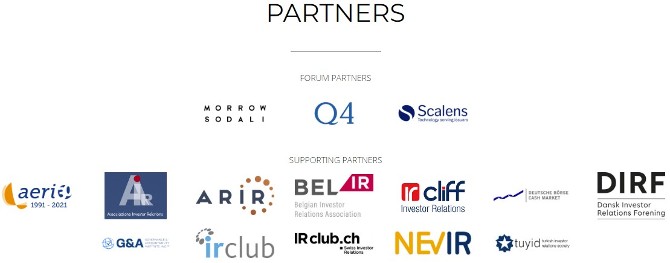Leading IR, sustainability and governance professionals gathered in London this week to share insights and expertise on ESG issues facing UK and EU companies. The ESG movement is facing challenges with increased scrutiny from regulators and investors, as well as political backlash. But ESG issues remain top of mind for stakeholders and shareholders. The forum was an opportunity to hear different perspectives and stories about ESG integration from corporates, investors and IROs.
It looked at where the ESG strategy fits in a company’s overall business purpose, how to build a good narrative around ESG commitments, what companies are focusing on beyond climate, the impact of Covid-19 on the S in the ESG acronym and the importance of ESG data collection.
ESG in the business strategy

One of the sessions looked at how companies can integrate ESG into the highest level of corporate strategy and how they can ensure messaging is consistent across the business, as well as the risks and opportunities around it.
For Derek Harding, CFO at Spectris, the ESG effort is not separate from the overall company strategy. ‘I wouldn’t have a separate ESG strategy – it has to be part of what you do,’ he said during the session.
Answering a question around who within a company is responsible for building a successful strategy, Harding said it’s a collective effort that includes the company and the people it engages with.
‘What’s quite interesting to me is the power has shifted, I think, toward the broader society,’ he said. ‘The board in the old days would have taken control, shareholders might have influenced the board, but with social media, with choice, with so many big issues, employees, customers, society all have the opportunity to really influence you as a company, and you have to be very aware of all of the different aspects, which is why it’s bigger than one person’s job.’

Sharing his perspective was Richard Lacaille, senior adviser and ESG lead at State Street. Asked what steps companies can take to embed ESG into their strategy, he said: ‘The starting point [is to ask]: what’s the purpose of the business?’ he suggested. ‘Then how does the business affect the different stakeholders and therefore how do we ensure ESG is considered as part of the business strategy to [ultimately] meet the purpose of the business. That’s the kind of sequencing I would suggest.’
Navigating ESG regulations
Alongside changing shareholder priorities, public companies across Europe are facing a wave of new ESG regulation. Another session looked at the impact of EU taxonomy, the Corporate Sustainability Reporting Directive, how EU regulations are influencing UK regulators, how businesses are managing the complexity of new frameworks and the pace at which new rules are being adopted.

William Houston, senior IR and ESG manager at BAT, noted: ‘You’ve got to be very comfortable with the uncertainty and you can’t know everything – there is a horrific amount of information out there. So you’ve got to go through a learning process [to reach] a level where you’re competent in the timeline of regulation. After that, you just sort of monitor things. It’s actually about educating people internally.’
In the UK, the introduction this year of mandatory TCFD reporting is helping to boost awareness of climate-related risks and ensure companies step up their ESG plans.
Panelists looked at what TCFD means for UK firms. Lili Huang, head of investor relations at discoverIE Group, said the new regulation poses some challenges – particularly for smaller firms – as it pushes businesses to think long term.
‘I have to say [there is a] challenge – particularly for small and mid-cap companies in the UK – because what they’re asking you to do is a long-term [assessment] of how [ESG issues are] going to impact your business,’ she said. ‘But all of us here know that [for businesses] this is only planned for three to five years and for some of them probably one year. So aligning this with your kind of long-term scenario analysis and with your business planning is a challenge.’
Keeping control of the narrative

As the regulatory landscape changes quickly, some companies struggle to deliver a concise and compelling ESG narrative to the investor community.
While developing a ‘robust and holistic’ ESG strategy is crucial, ensuring the target audience understands and engages with it is even more important. A panel of leading IROs and corporates looked at how stakeholder expectations are changing and what it is important to prioritize in ESG dialogue.
‘There are two pools of stakeholders,’ said Tish Crawford-Jones, IR director at Q4. ‘You’ve got your internal stakeholders and therefore, having ESG as part of your business strategy is going to be the most important thing. And then you have your external stakeholder base, which is fundamentally the investors. So how are you going to make sure you are communicating that [ESG strategy] correctly?’
‘That is done by having an ESG page [on the website] because that is where predominantly most investors go these days and then having that feedback loop, making sure you understand what your investors are saying about you. Also, what your employees are saying about you and making sure you’re answering those questions.’











